Buying guide
We have produced the buying guide below to help you through the sometimes confusing process of choosing your range cooker. Click on the relevant sections to see your various options explained.
Of course, should you need any further advice you can just give us a call on 01244 402975 - we'd be only too happy to help you find the right cooker to suit your needs and your budget.
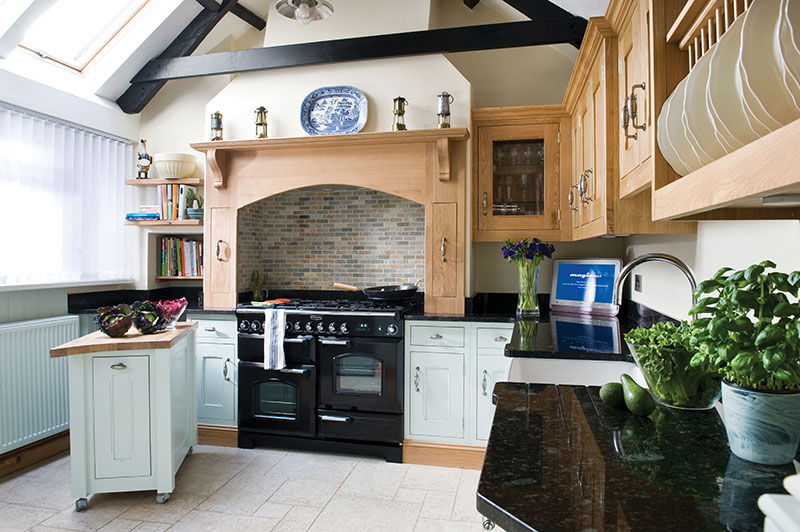
Range cooker formats
Choosing the right fuel type is clearly important, and can be influenced by efficiency, safety, speed, gas/electrical supplies and aesthetic appeal ...
All electric ranges
Some people do not have access to a gas supply, or simply prefer the benefits of an all-electric range. The vast majority of electric range cookers now offer an induction hob which is fast, efficient and safe, and largely considered the more environmentally friendly fuel choice. This is largely down to the method of heating the pan rather than the food (hence less energy wasted to the surrounded environment) and the increasingly renewable methods of producing the electricity used to power induction hobs, rather than burning gas.
All-electric ranges will obviously draw more electricity than their counterparts, and you will therefore need a sufficient electrical supply in place. In most cases this will mean a 10mm heat-resistant cable into a 45Amp fused circuit via an easily accessible double-pole switch, but the rating could be as high as 60Amp (with the exception of Stoves and Belling who offer induction cookers to run off a 32amp connection). Please consult a qualified electrician if in any doubt. The rating for your chosen range will be shown on our product specification table, although we recommend checking this with the manufacturer prior to ordering.
Induction cooking is an increasingly viable choice in domestic cooking and is beginning to eclipse dual fuel as the most popular fuel type.
Dual fuel ranges
A dual fuel range uses both gas and electricity, and you will need a mains or LPG gas supply in place, together with an electrical supply sufficient for your chosen model.
LPG conversion
Although your range will usually arrive configured for mains gas, almost all dual fuel ranges will convert for use with LPG (bottled) gas, and a set of LPG gas jets will either be supplied with the product, or this will be available for a small charge from the manufacturer.
Gas ranges
Many people prefer using an all gas range cooker, as they have grown used to the moister results of a gas oven. Alternatively, a high-current electric circuit may not be available, and a gas cooker is an ideal solution. You will still need an electricity supply to run the timer, ignition and lights, but this will usually be via a 13Amp plug rather than a dedicated cooker circuit.
All-gas cookers need to be purpose-built for the type of gas used, and are usually NOT convertible. It is highly dangerous to use the wrong gas type, so ensure you seek professional advice from a Corgi-registered engineer.
Most UK households will have Natural Gas piped into their property. More remote properties will often be using Liquid Petroleum Gas (LPG) in the form of Butane or Propane, via large tanks or smaller bottles. In the Channel Isles, although the gas supply may be piped into the house in the normal way, the gas used is LPG mixed with air.
LPG ranges
As the demand for all-LPG ranges is very low, many manufacturers have dropped them from their product range in recent years. Only a few models are now available, and Rangemaster is the only major brand still offering them, with one or two others offering single cavity models.
All-gas cookers need to be purpose-built for the type of gas used, and are usually NOT convertible. It is highly dangerous to use the wrong gas type, so ensure you seek professional advice from a Corgi-registered engineer.
Induction cooking
Induction technology has been used in professional kitchens for over 40 years, but is relatively new to the domestic scene. The first brand to introduce induction to a range cooker was Stoves, who launched their Sterling 1100E model in 2007. Induction cooking can still be something of a mystery to many consumers, but the advantages are manifest, and new users of induction hobs often wonder why they ever cooked on anything else.
How Does it Work?
A powerful electro-magnet below the hob's glass surface acts directly on the molecules of the ferrous material in the pan above, exciting them to the point where heat is produced. Because the rate of excitement can be directly controlled by the electrical flow to the magnet, the effect of any adjustment is immediate.
Why Choose Induction?
Fast and Responsive
Induction is fast! Even better, it powers up instantly and switches off immediately, making it controllable like gas but almost twice as fast. It can take only seconds for water to begin to boil on an induction hob. Reducing the pan to simmering is equally quick, as there is little residual heat to slow things down. Useful functions can include:
Auto Heat-up function
powers up to maximum before automatically reducing to a given setting.
Power Boost
When needed, power is drawn to a single zone for extra intensity. Great for wok cooking.
Uniform Cooking
Another benefit of induction is that because the heat is distributed evenly throughout the pan floor and walls you are far less likely to burn the contents, and there is less need to stir to spread the heat evenly - great for jams and sauces!
Energy Efficiency
Induction is considered to be 25% more energy efficient than ceramic heat sources and 30% more than gas. Induction zones are faster and more energy-efficient than radiant ceramic zones because the induction technology uses only enough energy to heat a particular pan, rather than heating up an element, the glass surface and then the pan, so any heat-loss is minimal.
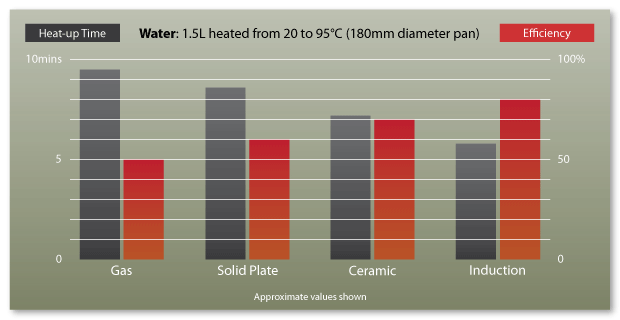
Touch Controls?
Although usually controlled using rotary knobs, range cookers with induction hobs will sometimes feature touch controls, and all will have a digital power-level display. Because the surface does not get dangerously hot the touch controls can be positioned on the surface of the hob itself, removing the need for additional control knobs on the front of the cooker.
Clever Functions (check your chosen product's spec)
Timers are often featured, allowing you to set simmering times to avoid boiling dry.
Pause function - if the doorbell goes, just pause then go back to where you were.
Recall function - saves your last setting, so you can repeat a favourite process.
Auto switch-off - pre-set the switch off time for peace of mind and convenience.
Keep-warm function - a slow trickle of power which is just right for delicate sauces, melting chocolate, etc.
Griddle or bridging zone - pairs-up two adjacent zones for use with a large griddle pan or fish kettle.
Safety Benefits
Only heat conducted back from the pan will effect the cooking surface, and quite locally, so induction is particularly safe to use. It is possible that after long cooking spells the glass surface may get hot to touch, so residual heat indicators alert users should the temperature rise above 60°C. Also look out for:
Child safety locks, which invariably feature as standard.
Safety shutdown - if unattended for a long period all zones are automatically switched off.
Pan overheat sensors - if anything boils dry, the zone will automatically switch off.
Easy to Clean
With just a smooth glass surface to wipe over, and no burnt-on spillages, induction hobs are a breeze to clean. There are proprietary ceramic hob cleaners available from supermarkets for the occasional spruce-up.
Will I Need New Pans for Induction?
The only requirement of pans for induction usage is to have a ferrous, or magnetic, base. You may already have some suitable pans:
Stainless Steel - Unless they have been made especially, with a steel plate embedded in the base, normal stainless steel pans may not work well with induction, as the ferrous content is relatively low.
Enamelled Steel - Pans in enamelled steel, with or without non-stick coating, will work very well.
Cast Iron - Great with induction, but to avoid the risk of scratching the glass top of your hob use pans with an enamelled base, or avoid sliding the pan across the glass surface.
Enhanced Aluminium Pans - Aluminium is a great conducting material, but you will need induction-suitable pans with a thick base, as this ensures more even cooking.
Incompatible Cookware - Glass, ceramic or earthenware pans, aluminium pans (unless they have a special base), copper pans.
Electric ovens (overview)
Electric ovens
An electric oven can often provide you with a good deal of cooking flexibility. In addition to conventional (zoned heat) electric ovens, most ranges will feature a fanned or multi-function oven, or perhaps a mixture of all three types.
Pre-heating
A major advantage of electric ovens is fast warm-up times compared to gas ovens. Fanned ovens are particularly good in this respect, and In addition to added convenience, will also save energy. To get the best results from a conventional gas or electric oven, you will need to allow 10 to 15 minutes before placing your dishes in (compared to 3 to 4 minutes for a fanned oven). Placing-in food only when the oven is to temperature is especially important when cooking chilled or frozen foods.
Conventional electric ovens

Conventional electric ovens
Many range cookers will include a conventional oven in addition to a fanned oven, and this traditional method of heating an oven uses a single heating element in the base and allows natural convection to distribute heat throughout the oven cavity. This results in a higher temperature in the top section and a cooler lower section.
Very suited to traditional roast meals, the different temperature zones allow you to cookthe meat, for example, on the middle shelf, the potatoes on the top and the pudding towards the bottom.
Slow cook ovens
A slow cook oven is used to cook stews and other liquid-based dishes at relatively low temperatures, with correspondingly long cooking times. Many recipes simply call for the ingredients to be put in the dish with little preparation so, for example, you could throw together a casserole before leaving for work and it will be ready when you come home. Slow-cooked stews and hotpots tend to taste better, as the meats are beautifully tender and the juices more succulent. Rice puddings come out great, too!
Dedicated slow cook ovens
Many Stoves and Belling products (also the Rangemaster Excel) now feature a dedicated slow cook oven, usually the small cavity on the lower right, heated by a low-powered electrical element. This can obviously free-up your main ovens for preparation of the rest of the meal, and when not used for cooking can also prove useful for plate-warming.
Integrated slow cook functions
Many gas ovens will feature a slow-cook setting on one of the main ovens, which is controlled by a simple on/off switch or a setting on the control knob.
Fanned electric ovens
Fanned electric ovens
Most double-oven range cookers will include at least one fan oven, which is a great asset to cooking in general, and great for batch baking, as the heat is very evenly spread throughout the oven cavity. Because they are very efficient, fanned ovens will also reach temperature much quicker than a conventional oven, saving you both time and energy costs. In addition, you will be able to set a cooler temperature than your recipe shows.
Fanned ovens also offer additional functions, as described below.

Fanned cooking
A very efficient and economic way of heating your oven cavity, the heating element is actually part of the fan assembly, and the resulting effect is a very uniform heat throughout the oven, which is ideal for batch baking of cakes or canapés, and cooking in general.

Defrost
Using the fan without any heat and with the door closed allows you to defrost foods such as bread, cream cakes or gateaux. If you leave the door open, this can also be used for cooling dishes prior to refrigeration.
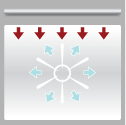
Fan assisted grilling
Used with the door closed, on this setting the fan circulates the heat from the grill element around the food itself, eliminating the need to turn or baste chops, sausages, mixed grills and so on. It will also significantly reduce the spitting fat often associated with traditional grilling.
Multifunction ovens
Multifunction ovens
Many brands are now featuring Multifunction ovens on their range cookers, which is good news if you enjoy cooking, as you will certainly come to appreciate the flexibility this offers. Selecting the most appropriate heat for the meal you are preparing will make a real difference to the way it turns out, and you will wonder how you coped with your old cooker!
Although availability of functions may vary slightly from brand to brand, the guide below will show you how to use them to best advantage.

Conventional cooking
Using natural convection, the oven cavity will be hotter at the top and cooler at the bottom, which is ideal for traditional roasting. The meat can be placed in the middle of the oven, roast potatoes towards the top, and puddings towards the base.

Top heat only
Again useful towards the end of cooking, when you need to finish off a dish but do not want the ferocity of the grill you can use the top oven element for delicate browning. Great for dishes like lasagne, cottage pie or cauliflower cheese.

Bottom heat only
Towards the end of cooking using fanned or conventional modes you can use this function at higher temperatures to finish off the bases of foods like pizzas, pies and quiches. At lower temperatures it can also be useful for slow-cooking casseroles or plate-warming.

Base heat with fan*
Used to cook open pies (such as mince pies, apple tarts etc.) the base element ensures that the base is cooked, while the fan allows the air to circulate around the filling - without being too intensive.
*Stoves and Belling ranges
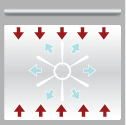
Fan assisted
Suitable for food with a high moisture content, such as roasted meats, baked fish, bread and frozen potato products. It also eliminates the need for baking pastry blind.

True fan
This gives the oven a very uniform heat, so is ideal for batch baking of cakes or canapés. A very efficient and economic way of heating your oven cavity, it can also be used for a quick pre-heat boost.

Quickstart or Rapid Response
It is always important to preheat an oven to the correct temperature, and this useful feature can make this easy by providing a very fast preheat system, sometimes allowing you to put food in straight away.

Defrost
Using the fan without any heat and with the door closed allows you to defrost foods such as bread, cream cakes or gateaux. If you leave the door open, this can also be used for cooling dishes prior to refrigeration.

Traditional grilling
Although you can use this for grilling meats, it is most suited to toast and other bread-based snacks like crumpets, teacakes and welsh rarebit.

Fan assisted grilling
Used with the door closed, on this setting the fan circulates the heat from the grill element around the food itself, eliminating the need to turn or baste chops, sausages, mixed grills and so on. It will also significantly reduce the spitting fat often associated with traditional grilling.

Oven light only
Although not what we would call a "real" function, the light-only mode is often included when specifying the number of functions available, and is most economically used by switching on and off when you need to check the progress of your food. It can also prove useful when you come to clean your oven!
Gas ovens
Gas ovens
Gas ovens use natural convection to distribute heat throughout the oven cavity. This results in a higher temperature in the top section and a cooler lower section. Although not as quick to warm up as fanned or multifunction electric ovens, many people prefer gas ovens because they have become accustomed to using them, or perhaps prefer cooking in the slightly moister air they generate, which is excellent for baking.
Very suited to traditional roast meals, the different temperature zones allow you to cook the meat, for example, on the middle shelf, the potatoes on the top and the pudding towards the bottom.
Oven features
Internal oven features
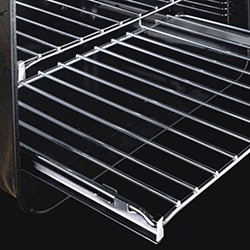
Telescopic shelves
A remarkably useful feature available as standard with some brands (e.g. Stoves, Mercury), and as an optional accessory on others, telescopic shelves operate on steel runners like a drawer. The smooth action of the slide-out shelf makes accessing your food easier and safer than with conventional shelves. There’s no need to reach into a hot oven, simply pull out the shelf and the food comes to you without the risk of tipping or spillage.
Although the telescopic runners are placed at specific useful heights, the shelf can be removed for easy cleaning or for alternative conventional positioning.
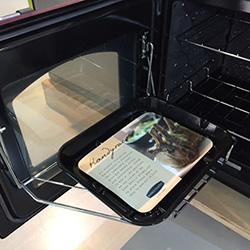
Rangemaster Handyrack
Available on Rangemaster range cookers and under a different name on Leisure ranges, the useful Handyrack is a great feature. The Handyrack is a removable shelf attached to your main oven door, which swings out when the door is opened, making basting and accessibility very easy. This means you no longer have to move your roasting tray in and out of your hot oven.
Adjustable positions
When the Handyrack is used in its highest position, other dishes can be cooked on the bottom shelf position of the oven or standing on the base of the oven. When the Handyrack is used in its lowest position, other dishes can be cooked on the second shelf position of the oven or standing on the base of the oven.
Safety advice
The maximum weight that can be held by the Handyrack is 5.5kg (12lb). It should only be used with the supplied meat tray, which is designed to fit the Handyrack. Any other vessel could be unstable.
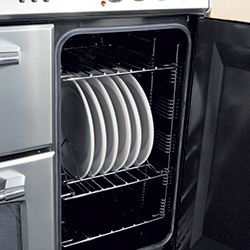
Plate racks
When you may have spent hours making dinner it seems a pity to spoil things by placing the food onto cold plates. Warm plates will retain the food’s temperature during an extended dinner, and your guests will certainly appreciate it.
Plate racks are supplied as standard on most 90cm Rangemaster and Stoves ranges which feature a tall oven, and allow you to stack plates sideways to warm them through.
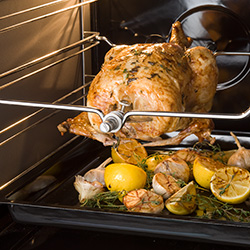
Rotisseries
A superbly succulent way to cook pork, chicken, duck and other game birds. As the rotisserie uses the grill element, spitting of fat it virtually eliminated, which helps maintain a clean oven cavity. The rotation cooks the meat evenly in its own juices and allows easy access for continuous basting if desired.
The motor drive mechanism is concealed within the oven wall and turns the food on the spit.
Oven linings
Standard enamel
Although some products feature self-cleaning linings, these will add to the cost of a product, and the familiar wipe-clean enamel is still a standard feature on many range cookers.
Cleaning
The key to avoiding turning the cleaning of your enamelled oven into a big and rather unpleasant job is to ensure that you adopt a "clean as you go" habit, and perhaps keep a baking tray on the floor of the cavity to catch any spillages.
If excessive splashing does occur in the oven, wait for the oven to cool down and then wipe the affected enameled area with a damp cloth wrung out in warm water and a mild detergent.
Any obstinate marks can be removed using a paste or cream cleaner or a well moistened soap impregnated steel wool pad rubbed gently so as not to damage the surface.
Easy-clean and Pristine enamels
Pristine® Enamel is an award-winning finish developed by and exclusive to the Stoves brand, but similar enamels can be found on other brands. Rather than opt for a self-cleaning lining, Stoves have chosen to adopt this less costly but very effective solution, with an exceptionally hard and smooth surface which is very difficult for stains to cling to.
Following exhaustive tests* involving a variety of ovens, Stoves were able to ascertain that Pristine enamel is three times easier to clean than standard enamel. Because the structure of the enamel is more compact, the absorption of food residue is greatly reduced, making it possible to just wipe it clean. In addition, Pristine’s unique formulation also offers inherent antibacterial qualities.
*The Vitreous Enamel Association has endorsed these tests and findings.
Cleaning - If excessive splashing does occur in the oven, wipe the affected enameled area with a damp cloth wrung out in warm water and a mild detergent. Any obstinate marks can be removed using a paste or cream cleaner or a well moistened soap impregnated steel wool pad rubbed gently so as not to damage the surface.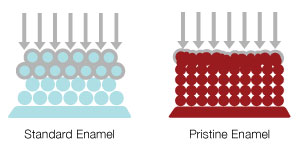
Catalytic oven liners
Variously referred to as Self-clean, Stay-clean, or Cook & Clean, these liners are included on many ranges, or may be available as an optional extra. They can often be recognised by their rough-textured grey surface. The liners normally fit to the sides and rear of the oven, but are sometimes available for the roof of the cavity too. Usually both oven cavities will be lined, but sometimes they will be found only in the main oven.
How they work
Catalytic liners are coated with fat-hungry micro-porous enamel and help absorb and eliminate the splashes that occur during cooking. This does not stop all marks on the lining, but helps to reduce the amount of manual cleaning needed. The panels work better above 200°C so if you do most of your cooking below this temperature, at the end of cooking (especially after roasting) leave the oven on its maximum setting for a further 15 minutes to allow the stay-clean process to do its work.
Cleaning liners
If a lot of liquid or fat has splashed the oven interior, wait until the oven has cooled down, then clean the splashes with a damp sponge. Then heat the oven for 2 hours on maximum. Repeat the cycle if certain difficult marks have not been eliminated. Periodically, it is advisable to remove the panels from the oven and wash them with lukewarm soapy water and dry them with a soft lint free cloth. The panels should then be dried and replaced and the oven heated at 200°C for about one hour. This will ensure the liners are working effectively.
- Do not use steel wool (Brillo) or any other materials that will scratch the surface.
- Do not use oven-cleaning pads.
- Never use abrasives, alkaline or acid detergents to clean the oven.
Pyrolytic oven linings
The holy grail of oven cleaning, pyrolytic ovens use heat to thoroughly clean the interior of the oven, leaving it looking like new. When the oven needs cleaning, the oven can be set to a very high temperate (the door is locked for safety), and all food residues are reduced to ash, which you simply brush from the oven floor once cool. This is an impressively effective process, but is a rare feature found mostly on top-end built-in ovens. On range cookers, pyrolytic ovens can currently be found on Smeg & Rangemaster FX models, but hopefully more will appear as demand rises.

